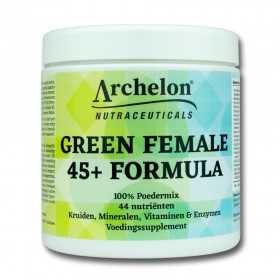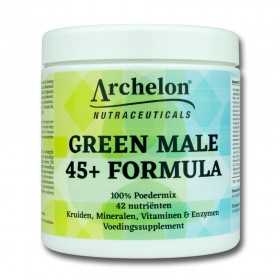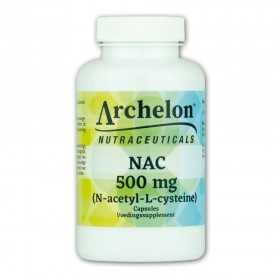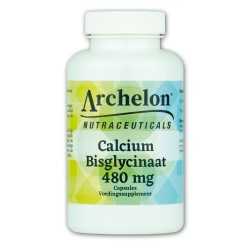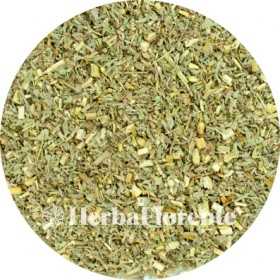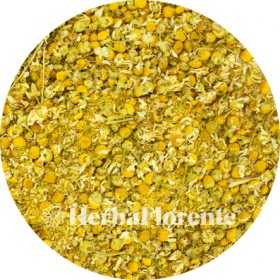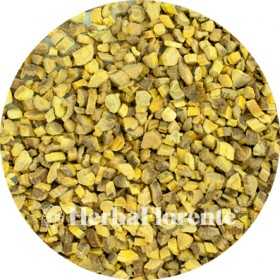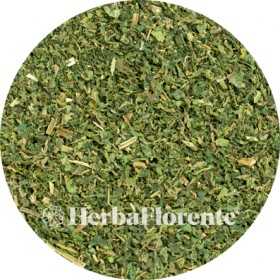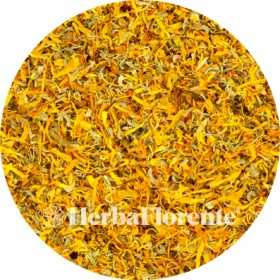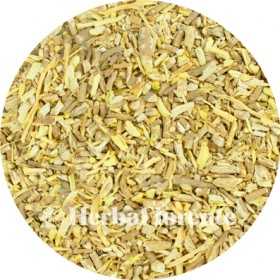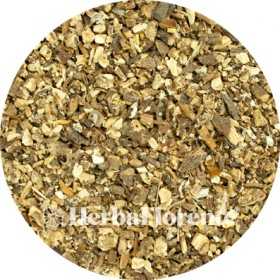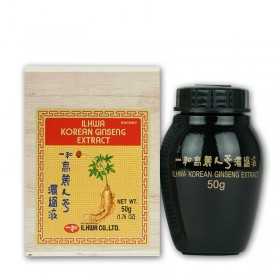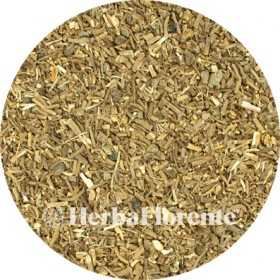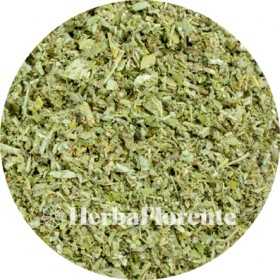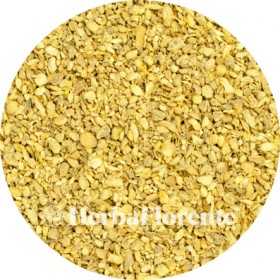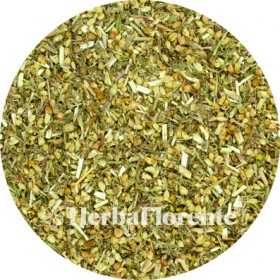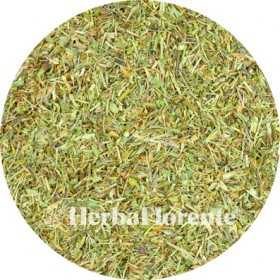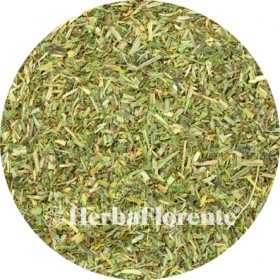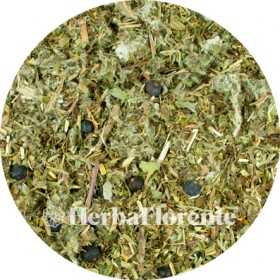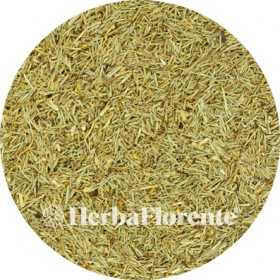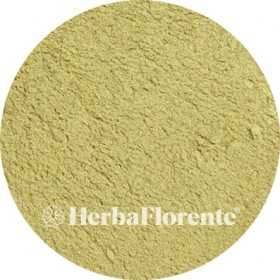Best sellers
There are 366 products.
Lungwort - Pulmonaria officinalis
Lungwort, belonging to the genus Pulmonaria in the rough-leaved family (Boraginaceae), owes its botanical name to the Latin word 'pulmo', which means 'lung'. This is because of the similarity that was seen between the drawing on the leaves of the spotted lungwort and (diseased) human lungs. According to the signature theory, the plant was previously used as a remedy for lung diseases because of this similarity. The Dutch name 'pulmonary herb' is directly derived from the botanical name, and this name also occurs in several other Western European languages.
€5.91
€6.95
From: €5.91
Calcium Bisglycinate - 480 mg
Calcium is available in different forms, one of the better forms being calcium bisglycinate. Calcium bisglycinate has good bioavailability. It is a chelated form of calcium bound to two (bis) molecules of the amino acid glycine, which has more benefits for the body. Calcium is also involved in many body processes, including blood clotting, energy metabolism, muscles, bones, teeth, digestion, nervous system and cell division.
Today, many minerals are available in their inorganic form as nutritional supplements, such as oxides, carbonates and sulphates. However, these forms are poorly absorbed by our body. In nature, minerals occur in bioavailable forms, packaged in proteins, to prevent them from binding to other food components. This significantly increases their bioavailability.
Today, many minerals are available in their inorganic form as nutritional supplements, such as oxides, carbonates and sulphates. However, these forms are poorly absorbed by our body. In nature, minerals occur in bioavailable forms, packaged in proteins, to prevent them from binding to other food components. This significantly increases their bioavailability.
€23.95
Black Walnut - Juglandis nigrum
The shell of the black walnut (Juglans nigra) comes from the immature fruits of the black walnut tree (Juglans nigra).
Black walnut (Juglans nigra, also known as 'black nut') is a species of walnut that grows naturally only in the United States and Canada, hence the term American black walnut. Juglans nigra belongs to the walnut family.
The fruits are dark brown and have a strong odor distinct from European walnuts. In America, the use of black walnut has long been common among herbalists. It is often used in the form of an extract or tincture in herbal medicine, because this way the active substances are optimally preserved. The fruits are edible and contain polyphenols, tannins, juglon, tannins and omega fatty acids.
Black walnut (Juglans nigra, also known as 'black nut') is a species of walnut that grows naturally only in the United States and Canada, hence the term American black walnut. Juglans nigra belongs to the walnut family.
The fruits are dark brown and have a strong odor distinct from European walnuts. In America, the use of black walnut has long been common among herbalists. It is often used in the form of an extract or tincture in herbal medicine, because this way the active substances are optimally preserved. The fruits are edible and contain polyphenols, tannins, juglon, tannins and omega fatty acids.
€2.50
From: €2.50
Wormwood Herb - Artemisia absinthium - Cut
Absinthe wormwood (Artemisia absinthium) is a plant from the composite family (Asteraceae). This species is on the Dutch Red List of plants as quite rare and moderately reduced in numbers. It is a perennial plant that grows naturally on dry, calcareous, nitrogen-rich and cultivated soils in temperate regions of Europe, Asia and North Africa. The genus name Artemisia is derived from the Greek hunting goddess Artemis.
The buds of wormwood absinthe are traditionally seen as medicinal. The bitter extract of these buds is an important ingredient in drinks such as vermouth and classic absinthe. The most important flavorings are absinthine and the menthol-smelling terpene thujone.
The buds of wormwood absinthe are traditionally seen as medicinal. The bitter extract of these buds is an important ingredient in drinks such as vermouth and classic absinthe. The most important flavorings are absinthine and the menthol-smelling terpene thujone.
€2.00
From: €2.00
Chamomile (Flower) - Matricaria recutita, Chamomillae europ. - Whole
True chamomile, also known as Matricaria chamomilla or Matricaria recutita, is native throughout Europe and widely cultivated in countries such as Hungary and Eastern Europe. The ancient Egyptians revered chamomile as the flower of the sun god Ra. The herb is known for its supportive effect on the immune system, soothing effect on the respiratory tract and promoting digestion. Additionally, chamomile is often used as a natural sedative and to promote restful sleep.
€2.95
From: €2.95
Licorice (Without Bark) - Glycyrrhiza glabra, Liquiritiae
Licorice (Glycyrrhiza glabra) is a versatile herb that plays an important role in Ayurvedic medicine. It is known for its beneficial effects on digestion and maintaining flexible joints, while also soothing the respiratory tract.
This plant is grown in various parts of the world, including Europe, Asia and the Middle East. It is a hardy plant that even thrives in the Netherlands. However, it takes three to four years before the roots can be harvested.
In addition to the roots, the leaves can also be used, for example to make tea. Licorice is widely used in foods and pharmaceuticals because of its sweet taste and other ingredients.
This plant is grown in various parts of the world, including Europe, Asia and the Middle East. It is a hardy plant that even thrives in the Netherlands. However, it takes three to four years before the roots can be harvested.
In addition to the roots, the leaves can also be used, for example to make tea. Licorice is widely used in foods and pharmaceuticals because of its sweet taste and other ingredients.
€2.25
From: €2.25
Nettle (Herb) - Urticae dioica
The nettle (Urtica dioica) is a powerful and versatile plant that occurs in many places, despite its irritating property to the touch. Known for its culinary uses, such as nettle soup and tea, the nettle is also known for its health benefits.
Nettle leaf is a traditional herbal medicine with various applications. It contributes to healthy skin, gives shine to the hair and strengthens the nails. In addition, it can help soothe the respiratory tract and maintain proper fluid balance. It also provides support to the heart and blood vessels.
Nettle leaf is a traditional herbal medicine with various applications. It contributes to healthy skin, gives shine to the hair and strengthens the nails. In addition, it can help soothe the respiratory tract and maintain proper fluid balance. It also provides support to the heart and blood vessels.
€2.00
From: €2.00
NAC (N-Acetyl-L-Cysteine) - 500 mg
N-acetyl-cysteine (NAC) is a form of the sulfur-containing semi-essential amino acid L-cysteine. It is found in dairy, meat, fruit and vegetables, but this is often insufficient and can best be supplemented through supplementation. The advantage that N-acetyl-cysteine has over cysteine is that it is better and more easily absorbed by our body. Furthermore, N-acetyl-cysteine supports production of the important tripeptide glutathione in our body. Glutathione plays a role in protecting our cells against oxidative stress.
€24.95
Lemon Balm - Melissa officinalis
Lemon balm (Melissa officinalis) is a perennial plant from the Lamiaceae family known for its lemony scent. This plant grows mainly in southern Europe, but can be easily propagated in temperate regions such as the Netherlands and Belgium, as it survives in winter via rhizomes. The plant reaches a height of about 0.5 meters.
Lemon balm has a long history; The plant was already known to various peoples 2000 years ago. The Arabs probably brought the plant to Europe via Spain, after which monasteries initially engaged in its cultivation. Ancient scriptures state that lemon balm leaves warm the stomach, aid digestion, dispel gloom and promote cheerful dreams. The leaves are often used in dishes, tea, oil or creams.
Lemon balm has a long history; The plant was already known to various peoples 2000 years ago. The Arabs probably brought the plant to Europe via Spain, after which monasteries initially engaged in its cultivation. Ancient scriptures state that lemon balm leaves warm the stomach, aid digestion, dispel gloom and promote cheerful dreams. The leaves are often used in dishes, tea, oil or creams.
€2.00
From: €2.00
Marygold (Calendula) - Calendulae officinalis
The marigold (Calendula officinalis) is a member of the composite family (Compositae or Asteraceae) and is often grown in ornamental gardens. This plant originally comes from Southern Europe.
It is an annual plant that usually bears orange, but sometimes yellow flowers. The marigold usually grows to a height of 30-45 cm and has blunt leaves. Its flowering period extends from May to November, while the fruits are often curved and boat-shaped.
Both fresh and dried flowers can be used in soups, and they also act as a natural coloring for cheese, butter and other foods. Historically, the petals were even used to imitate saffron.
It is an annual plant that usually bears orange, but sometimes yellow flowers. The marigold usually grows to a height of 30-45 cm and has blunt leaves. Its flowering period extends from May to November, while the fruits are often curved and boat-shaped.
Both fresh and dried flowers can be used in soups, and they also act as a natural coloring for cheese, butter and other foods. Historically, the petals were even used to imitate saffron.
€2.40
From: €2.40
A-C-D3 & Zinc
Vitamin A plays a crucial role in various biochemical and physiological processes in cells. It binds to retinoid receptors, which activate or deactivate genes involved in cell specialization.
Ascorbic acid is the pure form of vitamin C. People generally tolerate buffered forms of ascorbic acid better due to the lack of gastrointestinal complaints. Vitamin C is essential for the body.
Although our skin can produce vitamin D, this is often insufficient. Vitamin D supplementation is therefore often necessary, because this vitamin plays a role in various body processes.
Zinc is available in various forms, with zinc bisglycinate having excellent bioavailability.
Ascorbic acid is the pure form of vitamin C. People generally tolerate buffered forms of ascorbic acid better due to the lack of gastrointestinal complaints. Vitamin C is essential for the body.
Although our skin can produce vitamin D, this is often insufficient. Vitamin D supplementation is therefore often necessary, because this vitamin plays a role in various body processes.
Zinc is available in various forms, with zinc bisglycinate having excellent bioavailability.
€35.95
Ashwagandha - Withania somnifera - Cut
In Ayurvedic medicine, ashwagandha is known as a 'rasayana', meaning it is used to support both physical and mental health. It has a calming effect and is used to sleep better and promote a balanced mind. In India, where this herb originates, it is believed to support male potency and female health, often compared to the strength and vitality of a horse.
€3.00
From: €3.00
Dandelion (Root) - Taraxum officinale
Dandelion (Taraxacum officinale) has been known for centuries for its ability to support liver and gallbladder function. Both the root and the above-ground parts of the plant are rich in nutrients. In addition, dandelion has a beneficial effect on digestion.
The rich nutritional value of dandelions makes it advisable to regularly pick some fresh leaves in the wild and add them to salads. They are especially tasty in the spring. The fresh yellow flowers can be used as a cheerful decoration in salads and dried they can be processed into a 'wild' herbal tea.
Dandelions contain a high level of bitter substances, which always indicates that they are beneficial for liver and gallbladder function.
The rich nutritional value of dandelions makes it advisable to regularly pick some fresh leaves in the wild and add them to salads. They are especially tasty in the spring. The fresh yellow flowers can be used as a cheerful decoration in salads and dried they can be processed into a 'wild' herbal tea.
Dandelions contain a high level of bitter substances, which always indicates that they are beneficial for liver and gallbladder function.
€2.50
From: €2.50
ILHWA Korean Ginseng Extract
One of our top of the line products: 100% pure extract of undiluted ginseng. Very high content of ginsenosides. Produced by a low-degree vacuum concentrating process (read more “ILHWA Methods"), specially developed by ILHWA. Ginseng extract is an excellent health food with the healing properties of panax ginseng.
Panax Ginseng is a plant with a slow-growing, sturdy root. Panax Ginseng is considered one of the most important medicinal herbs in traditional Chinese medicine. In fact, it is even the world's most famous herb. Panax ginseng has been used for more than 5,000 years to optimize human health and well-being in Asia. In the world of Chinese ethnopharmacology, it has been used for more than 3,000 years.
Panax Ginseng is a plant with a slow-growing, sturdy root. Panax Ginseng is considered one of the most important medicinal herbs in traditional Chinese medicine. In fact, it is even the world's most famous herb. Panax ginseng has been used for more than 5,000 years to optimize human health and well-being in Asia. In the world of Chinese ethnopharmacology, it has been used for more than 3,000 years.
€53.50
From: €53.50
Valerian - Valerianae officinalis - Cut
Valerian (Valeriana officinalis) has been known for centuries for its relaxing and soothing properties, which is why it is often used for stress and to sleep better. It is a natural tranquilizer.
The reputation of the valerian plant stretches back centuries. The plant is still common in the Netherlands, mainly growing in airy, moist soil. The roots emit a strong and characteristic odor that cats are especially fond of. In the past, our superstitious ancestors used valerian to ward off 'evil'. For example, bridal couples wore wreaths of valerian leaves to ward off evil elves, while farmers used the herb to prevent 'milk bewitchment'.
The reputation of the valerian plant stretches back centuries. The plant is still common in the Netherlands, mainly growing in airy, moist soil. The roots emit a strong and characteristic odor that cats are especially fond of. In the past, our superstitious ancestors used valerian to ward off 'evil'. For example, bridal couples wore wreaths of valerian leaves to ward off evil elves, while farmers used the herb to prevent 'milk bewitchment'.
€2.40
From: €2.40
Sage - Salviae officinalis - Cut
True sage (Salvia officinalis L.) is a well-known herb that is used for various purposes. It has been used for centuries from China to ancient Rome. All kinds of magical properties were attributed to the little purple flower.
Sage is an antioxidant and can be used for menopausal symptoms. In addition, it supports normal menstruation. Sage is a natural soother for the throat, it supports the immune system and contributes to normal digestion.
Sage is an antioxidant and can be used for menopausal symptoms. In addition, it supports normal menstruation. Sage is a natural soother for the throat, it supports the immune system and contributes to normal digestion.
€2.00
From: €2.00
Ginger - Zingiberis Thiz. Mund. officinalis - Cut
Ginger comes from the root of the ginger plant (Zingiber officinale) and is used as a spice in many countries because of its strong flavor. It contains various bioactive substances, including gingerol, shogaol and zingiberene. Ginger supports the immune system, promotes healthy digestion and has a beneficial effect on the heart and blood vessels. Additionally, ginger can promote well-being during vehicle travel.
€2.40
From: €2.40
Zinc Bisglycinate - 75 mg
Zinc is available in different forms. Zinc bisglycinate has a very good bioavailability. It is a chelated form of zinc bound to two (bis) molecules of the amino acid glycine which has more benefits for the body. Zinc has a very wide range of action and is involved in many body processes. Zinc is essential for the activity of more than 300 enzymes that have the zinc ion as a cofactor. Zinc is also important for proteins and cell membranes. Zinc is important for the immune system, acid-base metabolism, carbohydrate metabolism, DNA synthesis, cognitive functions, fertility, reproduction, vitamin A metabolism, macronutrient metabolism, bones, hair, skin, nails, hormones and cell division, among other things.
€16.95
Yarrow - Achillea millefolii
Yarrow (Achillea millefolium) is an herb that belongs to the daisy family (Asteraceae). It is a winter-hardy, perennial plant that is common in the Netherlands. It has finely divided, feathery leaves and small white flowers that tend toward pink. The use of this herb has been around for centuries. Yarrow is used, among other things, to support digestion and promote fat metabolism. The herb is beneficial for the blood vessels, urinary tract and respiratory tract. It helps with normal menstruation.
€2.00
From: €2.00
Eyebright - Euphrasia officinalis
The Eyebright (Euphrasia officinalis) belongs to the broomrape family (Orobanchaceae) and mainly thrives in France, with the exception of the Mediterranean region. This plant can also be found in other parts of Europe, such as Germany, Austria and Scotland.
Traditionally, Eyebright was used to treat eye infections, but also for headaches and stomach complaints.
The Eyebright is an annual plant that usually grows between 10 and 25 cm high and is covered with numerous long glandular hairs. From May to September the plant blooms with white flowers that often have a light purple upper lip and a yellow spot on the lower lip.
Traditionally, Eyebright was used to treat eye infections, but also for headaches and stomach complaints.
The Eyebright is an annual plant that usually grows between 10 and 25 cm high and is covered with numerous long glandular hairs. From May to September the plant blooms with white flowers that often have a light purple upper lip and a yellow spot on the lower lip.
€5.00
From: €5.00
Woddruff Sweet - Galium aparine
Woddruff Sweet (Galium aparine) belongs to the star-leaved family (Rubiaceae). This plant is known for its ability to cling to objects it comes into contact with, thanks to the numerous hooks on both the stem and fruits. This causes plants and fruits to get caught in the fur of animals, resulting in widespread dispersal over great distances.
Cleaver leaves are widest above the middle and have one central vein. They grow together in whorls of seven. These leaves also have hooks, albeit less than the rest of the plant. The stem is thickened at the tips.
Cleaver leaves are widest above the middle and have one central vein. They grow together in whorls of seven. These leaves also have hooks, albeit less than the rest of the plant. The stem is thickened at the tips.
€2.50
From: €2.50
Detox (Blood-Liver-Kidney) Herbal Tea
Herbal tea composed of various herbs
Support for detox, Blood, Liver and Kidneys
Support for detox, Blood, Liver and Kidneys
€3.95
Field Horsetail - Equisetum arvense - Cut
Horsetail (Equisetum arvense), also known as horsetail because of its appearance, belongs to the horsetail family. It is known for its supportive properties for the skin, hair and nails, and it provides benefits for the liver and blood vessels. Horsetail extract has a natural calming effect and promotes a healthy moisture balance.
This plant thrives in different environments, such as meadows, along roads, on waste land and on slopes. Horsetail is one of the oldest plant species on earth, having existed for 390 million years. Thanks to its deep roots, horsetail can extract minerals from the depths of the earth. That is why horsetail is packed with valuable substances, including minerals, fiber and silicon.
This plant thrives in different environments, such as meadows, along roads, on waste land and on slopes. Horsetail is one of the oldest plant species on earth, having existed for 390 million years. Thanks to its deep roots, horsetail can extract minerals from the depths of the earth. That is why horsetail is packed with valuable substances, including minerals, fiber and silicon.
€3.95
From: €3.95
Wormwood Herb - Artemisia absinthium
Absinthe wormwood (Artemisia absinthium) is a plant from the composite family (Asteraceae). This species is on the Dutch Red List of plants as quite rare and moderately reduced in numbers. It is a perennial plant that grows naturally on dry, calcareous, nitrogen-rich and cultivated soils in temperate regions of Europe, Asia and North Africa. The genus name Artemisia is derived from the Greek hunting goddess Artemis.
The buds of wormwood absinthe are traditionally seen as medicinal. The bitter extract of these buds is an important ingredient in drinks such as vermouth and classic absinthe. The most important flavorings are absinthine and the menthol-smelling terpene thujone.
The buds of wormwood absinthe are traditionally seen as medicinal. The bitter extract of these buds is an important ingredient in drinks such as vermouth and classic absinthe. The most important flavorings are absinthine and the menthol-smelling terpene thujone.
€2.00
From: €2.00








